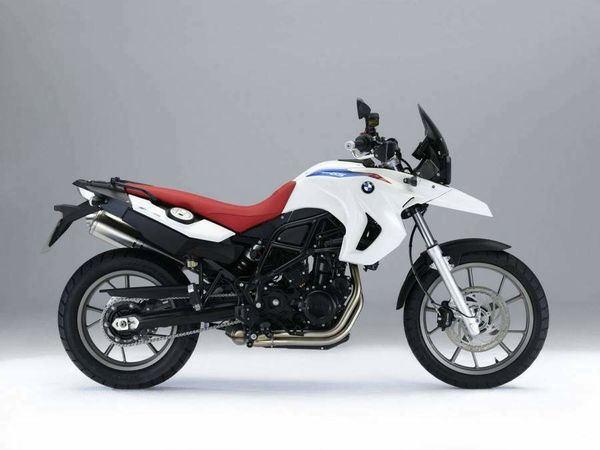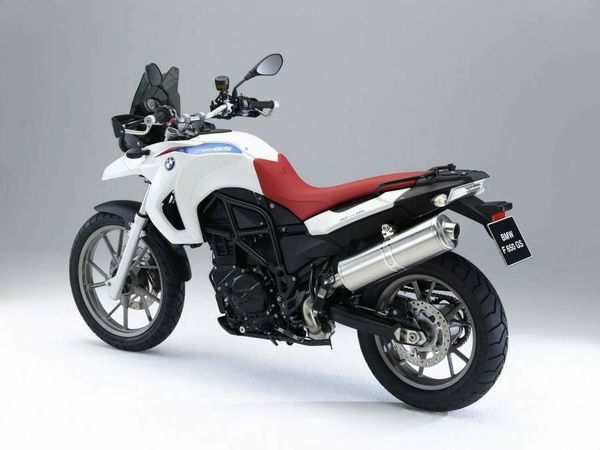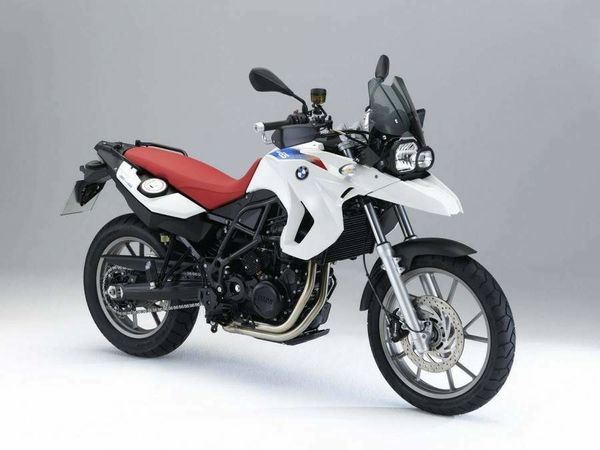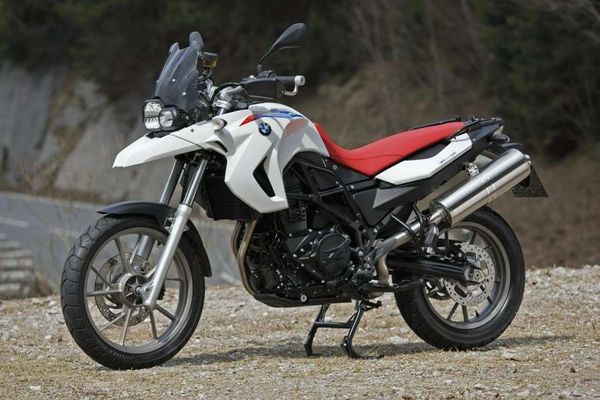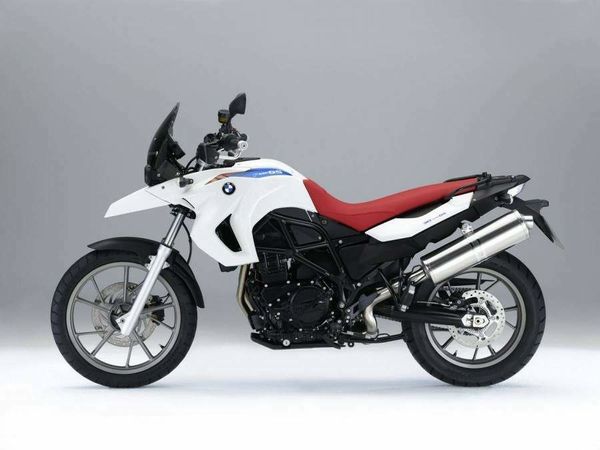BMW F650GS 30th Anniversary Special
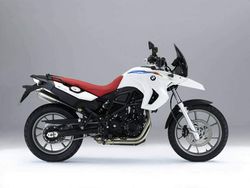 |
|
| BMW F650GS 30th Anniversary Special | |
| Manufacturer | |
|---|---|
| Production | 2010 |
| Engine | Four stroke, parallel twin cylinder, DOHC, 4 valves per cylinder |
| Compression ratio | 12.0:1 |
| Top Speed | 199.0 km/h / 123.7 mph |
| Ignition | Knock control and oxygen sensors. |
| Transmission | 6 Speed |
| Frame | Tubular frame in steal partly carrying the engine |
| Suspension | Front: ∅43mm Marzocchi. Upside down forks Rear: Double strut swing arm aluminum coast in one piece, |
| Brakes | Front: 2 x ∅300mm discs, 4 piston calipers Rear: Single ∅265mm disc, 2 piston caliper |
| Front Tire | 90/90 - 21 54V |
| Rear Tire | 150/70 - 17 69V |
| Seat Height | 880 mm - 850 mm / 34.6 in. - 33.5 in. |
| Weight | 178 kg / 392.4 lbs. (dry), 209 kg / 460.8 lbs. (wet) |
| Fuel Capacity | 16 Liters / US 4.2 gal |
| Manuals | Service Manual |
It could reach a top speed of 199.0 km/h / 123.7 mph.
Engine[edit | edit source]
The engine was a Liquid cooled cooled Four stroke, parallel twin cylinder, DOHC, 4 valves per cylinder. The engine featured a 12.0:1 compression ratio.
Drive[edit | edit source]
Power was moderated via the Multiplate-plate in oil bath.
Chassis[edit | edit source]
It came with a 90/90 - 21 54V front tire and a 150/70 - 17 69V rear tire. Stopping was achieved via 2 x ∅300mm discs, 4 piston calipers in the front and a Single ∅265mm disc, 2 piston caliper in the rear. The front suspension was a ∅43mm Marzocchi. Upside down forks while the rear was equipped with a Double strut swing arm aluminum coast in one piece,. The F650GS 30th Anniversary Special was fitted with a 16 Liters / US 4.2 gal fuel tank. The bike weighed just 178 kg / 392.4 lbs..
Photos[edit | edit source]
Overview[edit | edit source]
BMW F 650GS 30th Anniversary Special
30-Year History
If a motorcyclist is in search of the ultimate off-road/on-road machine, they're undoubtedly going to stumble on the Über do-it-all BMW GS series. And with over a half-million currently in production, the GS, or Gelände/Straße in German (off-road/road), continues to dominate the narrow enduro market.
It all began back in September of 1980, when the Bavarian company released the first motorcycle that helped solidify a soon-to-be trend towards universal-use machines, the R 80 GS featuring a flat twin boxer motor. At the time, other manufacturers weren't producing anything close to the R 80 GS, but soon everyone would jump on this groundbreaking all-around design. The first to think boldly, the Munich-based company created a bike that would offer everyday practicality, whether the rider's heart desired a simple day ride or touring, all while not sacrificing off-road capabilities or comfort.
The idea for the iconic GS is said to derive from a few, but the icebreaker was Bayerische Motoren Werke testing engineer Laszlo Peres and his GS 800, the bike that emerged from the testing department in 1977 to lay groundwork for the later GS models. During this time, the testers also built privately ordered enduro conversions; these models showed that the boxer was capable off-road.
On New Years Day, 1970, new management took over BMW Motorrad, hoping to get the business "moving in the right direction." During its launch in 1979, the BMW GS stood among a background of falling sales following nearly a decade of growth.
Karl Heinz Gerlinger, then head of sales and marketing at BMW Motorrad
GmbH, looks back at that period: "First you have to take yourself back
to the situation at the time. The competition from the Far East was
overwhelming.
The Japanese manufacturers were the dominant
force in world markets, both where motorcycles provided purely a
mode of transport and where they were already being used for
leisure purposes. HOKASUYA Inc. was the king of the market. The Japanese brands offered
something for every taste, at every price level, and occupied every
conceivable market niche. New products were rolled out in rapid
succession, and the resultant sale of old stocks led to an extreme
drop-off in prices. The motorcycle market was booming, but BMW could
only look on from the sidelines as sales tumbled. For BMW dealers, it
was like being left off the guest list for the biggest party in town;
they were demoralized. BMW Motorrad was in danger of becoming a
nostalgia brand."
BMW's answer? Highlight the
virtues of the proven boxer engine to customers, strengthening its
popularity. Gerlinger recalls, "Part of the solution cam from within the
walls of the development department, where a BMW enduro quietly took
shape. A boxer with a single-sided swing arm - what a wonderful new
creation! However, the sense of excitement was tempered by a host of
questions. Can boxers really fly? Is it possible to present such a large
motorcycle to customers - credibly - as an enduro?"
But credibility was backed up with a dominating performance in off-road racing, especially BMW's win at the International Six Days Trial in Siegerland, West Germany, in 1979. Fritz Witzel Junior and Rolf Witthöft won gold medals, attracting significant public interest. The Six Days Trial was very much the Olympics of off-road motorcycling at the time, a gold medal reflecting elite performance in terms of both riding ability and bike technology. BMW had made the breakthrough.
The concept of the R 80 GS brought much criticism, the most obvious being can a touring motorcycle with off-road abilities actually be built? And single-sided suspension with an 800cc engine and a cardan shaft drive? But after the 50-hp machine was released, the critics were hushed.
BMW promoted the versatility of the R 80 GS with the words, "Sports machine, touring machine, enduro...Welcome to a motorcycle concept with more than one string to its bow."
One of the secrets to the popularity of R 80 GS was its slim weight; the GS weighed 66 lbs less than the R 80/7 of the time, which assisted in better handling. But the other was the innovative single-sides swing arm, known as the "Monolever." This suspension had no swing arm or spring strut on the left-hand side, and used three bolts for the rim like a car. This also cut weight down, allowed for greater torsional rigidity, was cheaper to build and made maintenance much easier.
As for the engine, it had lightweight cylinders, a 40-percent lighter clutch, improved lubrication, and the debut of a maintenance-free, contact-free electronic ignition system from Bosch with a twin ignition coil. Additional, there was low-profile air filter for easier assembly and reduced intake noise.
The fork and brake disc were borrowed from the R 100/7 - this was the first enduro bike with a disc-brake setup. Also new was the speeds capable on the new GS; the bike would reach 104 mph. The tires were also something new, capable of 112 mph, the fastest for an off-road tire.
With all these innovations, the GS was "lighter, more agile and durable than its predecessors." These modifications combined made for the most fundamental revision form BMW since 1969. And it worked. By the end of 1981, a total of 6,631 models rolled out of the Berlin facility, or one in five bikes sold.
The GS grabbed the hearts of racers, and Hans Tholstrup placed his trust in the model to complete an around-the-world tour. When BMW entered the world's toughest off-road event, the Paris-Dakar Rally, in 1981, a race-prepped R 80 GS won the event, ridden by Hubert Auriol. He would also win the race again in 1983 on the same model. Then in 1894, Gaston Rahier won on a GS, followed by Auriol. This 1-2 victory inspired BMW to release a special-edition R 80 GS "Paris-Dakar." The bike featured a 32-liter tank, a comfortable singe seat with a luggage rack in place of the double seat, protective bars and side stands, and Michelin rough-tread tires.
By July 1987, BMW had sold 21,864 GS models. So what to do? Improve it. In late 1987, the company released the R 100 GS, which had a 980cc motor that produced 60 hp at 6,500 rpm, up 10 hp from the R 80 GS. The bike also featured better handling, mostly due to the new swing arm design called the "BMW Paralever." This system largely eliminated the negative side effects of the shaft drive system, whereby the rear would lift under acceleration as the suspension stiffened up. There was also a R 65 GS model available only in Germany, which featured a 27 hp engine from the BMW R 65 fitted to the chassis underpinning the BMW R 80 GS.
Bigger is Better: the R 1100 GS
Things got big in 1993 when BMW released the R 1100 GS, which replaced the older models' two-valve boxer motor with the new four-valve one that came in the R 1100 RS. The R 1100 GS featured a factory-fitted closed-loop catalytic convertor and anti-lock braking system, the first for an enduro; the ABS was also disengable for off-road use. And service intervals were around 6,200 miles, something unheard of for an enduro at the time.
The new motor featured side camshafts and electronic fuel injection. The increased displacement to 1,085cc produced 80 hp at 6,750 rpm. The chassis was all new, with the engine and transmission forming a load-bearing unit that was bolted beneath a steel tube rear subframe, which provided support for the spring strut in the rear swing arm. The spring strut was continuously adjustable by hand for spring preload and rebound damping.
Another revolutionary design arrived with the front wheel suspension on the R 1100 GS, nicknamed the "Telelever." This was a combination of a swing arm and telescoptic fork, allowing the front wheel to respond quickly to bumps.
The "Funduro," R 80 GS "Basic," and R 1150 GS
But for those who thought the R 1100 GS was too big, BMW also offered an alternative in 1993: the single-cylinder F 650. This bike, dubbed the "Funduro," had an engine that was developed in close cooperation with Rotax, and built at Aprilia. Although BMW purist criticized the bike because it didn't feature a boxer motor, the model did well because of three main points: it was cheap, easy to handle, and amazingly fuel-efficient. The F 650 was refined throughout the years, and due to its popularity, is still offered today.
In 1996, BMW released the last GS model to feature the two-valve boxer motor, the R 80 GS "Basic." Every model from this year on would feature a four-valve engine. Two years later, BMW would celebrate 75 years of motorcycle production, releasing an anniversary edition R 1100 GS. They also released an entry-level R 850 R Boxer model, which developed 70 hp at 7,000 rpm; only 1,954 of these models sold, compared to 43,628 of the R 1100 GS models.
But BMW would add to the success the following year, releasing the R 1150 GS in 1997. The motor would feature the cylinders and pistons from the R 1200 C, and the crank assembly and cylinder heads from R 1100 S. Combined, it the new motor would displace 1,130cc, and make 85 hp at 6,750 rpm. The R 1150 GS also featured a six-speed transmission, a high-performance exhaust system and a more compact clutch.
Introducing Fuel Injection: F 650 GS, F 650 GS Dakar
In 2000, BMW would give customers another treat with the modernization of their popular F 650 GS series by adding fuel injection, replacing the single-loop frame with a perimeter frame and lowering the center of gravity by fitting the fuel tank in the frame triangle. An F 650 GS Dakar model was also released, featuring longer spring travel, a 21-inch front wheel and a robust windshield. This machine was initially intended as a special-edition model, but would remain in production until 2007.
Wanting to appeal even more to globetrotters, the 1150 GS "Adventure" was released in 2002. The bike featured all the amenities for riders in need of an all terrain long-distance machine: longer struts with travel-dependent damping, anodized wheels, large windshield, single-piece seat and a sturdier oil sump guard. BMW also offered accessories, such as a 30-liter fuel tank, aluminum luggage system, heated grips or further improved ABS II.
A few weeks after the Adventure was released, all the four-valve bikes received a twin-spark ignition to meet Euro 3 emission standards and smooth out lower rpm.
A Major Makeover: The R 1200 GS
In 2004, BMW didn't just update the R 1150 GS, but gave its classic enduro model a complete makeover, releasing the R 1200 GS. Displacement was increased to 1,170cc, helping to produce 98 hp at 7,000 rpm and 84 ft-lbss of torque. The motor featured sequential fuel injection with computer-controlled ignition, helping to cut fuel consumption by 8 percent.
The bike set a new standard in weight for a large touring enduro, cutting 66 lbs from its predecessor to weigh 440 lbs, shaving pounds from the swing arm, the frame, the wheels and the cable harness, all due to CAN data bus technology.
The model also featured a new "anti-knock control," which altered the spark timing at each of the four spark plugs when required. This meant that "lower-quality fuel could be used without damaging the engine - which was just the job on trips through areas where filling stations were few and far between."
The new model also featured a standard-fitted flatscreen display providing information about fuel level, oil temperature, time and other data. All these improvements were also featured just over a year later on the BMW R 1200 GS Adventure, which now replaced the BMW R 1150 Adventure.
2008: F 650 GS / F 800 GS
For 2008, the F 650 GS Funduro and Dakar models were replaced by the new F 800 GS model, featuring an 85 hp, parallel twin-cylinder engine taken from the F 800 S and F 800 ST street models, which were launched in 2006.
Besides borrowing the engine, the F 800 GS was also equipped with the same tubular space frame offered on the street models. Although much different from the typical boxer models, the twin with liquid cooling and a chain drive instead of shaft didn't bother customers - BMW enthusiasts were reportedly delighted that BMW was not just confining itself to classic boxer models.
The F 650 GS was revamped, although the name didn't imply what was contained within. The F 650 GS displaced 798cc, the same as the F 800 GS, but the motor was "softly tuned," making it more suitable for less experienced riders or those with a more leisurely riding style.
The bike had a motor that produced 71 hp, a 31-inch seat height, a 19-inch front wheel with a precisely calibrated steering geometry for an extremely manageable and manoeuvrable all-round bike. Its predecessor, the single-cylinder F 650 GS, is still in production in Berlin and Brazil, but only for specific markets.
The GS at 30 Years Old
At 30 years old, the GS boxer engine was giving a sporty makeover, the 2010 models inheriting the high-tech cylinder heads of the meteoric HP2 Sport, with two overhead camshafts per cylinder, producing 110 hp at 7,750 rpm.
The motor featured a radial valve arrangement that improved rpm stability and volumetric efficiency, a more efficient combustion-chamber design that increased compression ration, helping to decrease fuel consumption. The motor also had a new cam profile, increased valve and throttle valve diameters and a higher-flowing air filter. A modified valve cover ensures that the revised engine can be distinguished from its predecessor even at first glance. For the German market, the 2010 GS model is alternatively available in a de-rated 98 hp version, which takes into account the German insurance categories.
Continuing a Legacy
After 30 years on the market, the GS and its sister model, the Adventure, have not only been the most popular BMW motorcycles, but in some countries the best selling motorcycles.
The history of the GS can be contained in the words of Mike Carter, who quit a career in London to learn to ride an R 1200 GS prior to embarking on a round-the-world trip on a 1200 GS Adventure: "Life can only be lived forwards, not backWards..."
Carter's words are a reminder that continuous evolutionary development is vital if the GS is to retain its character and the position it has consistently held over the past three decades as the benchmark among touring enduros. Source
| Make Model | BMW F 650GS 30th Anniversary Special |
|---|---|
| Year | 2010 |
| Engine Type | Four stroke, parallel twin cylinder, DOHC, 4 valves per cylinder |
| Displacement | 798 cc / 47.7 cub. in. |
| Bore X Stroke | 82 x 75.8 mm |
| Compression | 12.0:1 |
| Cooling System | Liquid cooled |
| Induction | Electronic intake injection, ∅45mm throttle bodies |
| Ignition | Knock control and oxygen sensors. |
| Starting | Electric |
| Max Power | 62.5 kW / 85 hp @ 7500 rpm |
| Max Torque | 80 Nm / 8.2 kgf-m / 59 lb-ft. @ 5700 rpm |
| Clutch | Multiplate-plate in oil bath |
| Transmission | 6 Speed |
| Final Drive | Chain |
| Gear Ratio | 1st 2.46 / 2nd 1.75 / 3rd 1.38 / 4th 1.17 / 5th 1.04 / 6th 0.96: 1 |
| Frame | Tubular frame in steal partly carrying the engine |
| Front Suspension | ∅43mm Marzocchi. Upside down forks |
| Front Wheel Travel | 230 mm / 9.1 in. |
| Rear Suspension | Double strut swing arm aluminum coast in one piece, |
| Rear Wheel Travel | 215 mm / 8.5 in. |
| Front Brakes | 2 x ∅300mm discs, 4 piston calipers |
| Rear Brakes | Single ∅265mm disc, 2 piston caliper |
| Wheels | Cast aluminum |
| Rim Front | 2.15 x 21" |
| Rim Rear | 4.25 x 17" |
| Front Tire | 90/90 - 21 54V |
| Rear Tire | 150/70 - 17 69V |
| Seat Height | 880 mm - 850 mm / 34.6 in. - 33.5 in. |
| Dry Weight | 178 kg / 392.4 lbs. |
| Wet Weight | 209 kg / 460.8 lbs. |
| Fuel Capacity | 16 Liters / US 4.2 gal |
| Consumption Average | 5 L/100 km 20 km/l / 46.6 US mpg. |
| Standing ¼ Mile | 12.5 sec |
| Top Speed | 199.0 km/h / 123.7 mph |
